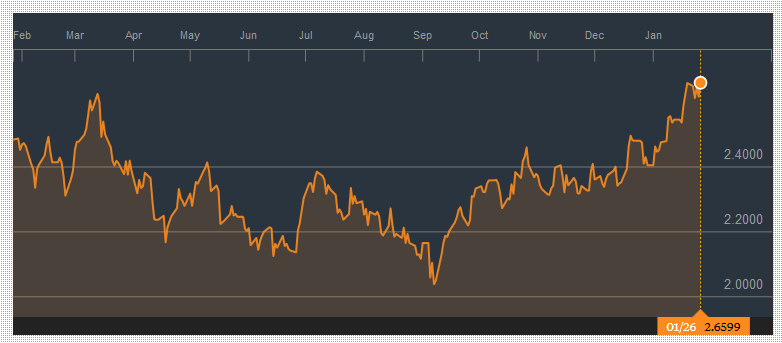Did US Treasury Secretary Mnuchin signal a change in the US dollar policy? Probably not. As Mnuchin and President Trump have done before, a distinction was drawn between short- and longer-term perspectives. In the short-term, a weaker dollar says Mnuchin, is good for US trade and “other opportunities”. In the longer-term, Mnuchin explicitly acknowledged, “the strength of the dollar is a reflection of the strength of the US economy.”
The market chose to focus on the first part of the comment because it was already selling dollars and this offered justification at an important inflection point. The dollar has strung together a 4-5 week slide despite macroeconomic conditions, including strong growth, tax cuts, the relative and absolute increase in interest rates, and the anticipation of additional Fed tightening, usually associated with a stronger dollar.
Mnuchin unknowingly pushed on an open door. “Unknowingly” because it did not break new ground, and Commerce Secretary Ross tried clarifying the statement relatively quickly. Mnuchin may have been the most surprised by the impact of his comments. One gets a sense that he is still learning the nuances of his position, and, perhaps, the disdain to which the Administration holds mainstream media, obscured how the media and markets hang on every word of the Treasury Secretary, especially about the dollar.
In some ways, Mnuchin’s precise meaning is unimportant. The point is that they were said within an important context. The Trump Administration just levied protective tariffs on solar panels and washing machines. It is expected to decide soon on steel and aluminum. President Trump has threatened action on China’s intellectual property rights violations as well.
The US is blocking the appointment of judges for WTO panels, which will jeopardize the conflict resolution mechanism (the teeth) of trade practices. Although President Trump has suggested that the NAFTA talks are progressing, many still fear that the talks will collapse due to US demands or withdrawal, as the President has threatened.
Through the mid-1990s, the US and other countries habitually wanted directly influence the foreign exchange market. Countries sought competitive advantage. However, beginning with Rubin’s “strong dollar policy,” best practices evolved toward letting markets determine exchange rates. This is now the official position of the G7 and G20. In effect, the foreign exchange market was de-weaponized.
That is the real meaning of the much-maligned strong dollar policy. The US would not use the dollar’s exchange rate to secure some trade or policy concession or purposely seek to depreciate the dollar to reduce its debt burden. With the disruption potential of the US administration, investors and allies are rightfully and genuinely concern that this is another part of the modern liberal global order that may be abandoned. It may be abandoned, but it is not being abandoned today.
As we noted, the dollar has been falling persistently since the middle of December. It looked as if there may have been a window of opportunity for it to stabilize this week. The technical conditions were stretched, market positioning extreme, and the Bank of Japan and European Central Bank would likely push against speculation of a near-term change in their respective policies.
Perhaps, concern about triggering the ire of the mercurial US administration, European and Japanese officials have been particularly circumspect in their remarks about their currencies strength. The new head of the Eurogroup (eurozone finance ministers) Centeno did not express concern about the euro’s strong appreciation. The ECB’s Constancio’s remarks were a bit more pointed but simply noted that premature tightening would jeopardize the inflation target. Japan’s Finance Minister Aso saw no problem with the dollar approaching JPY110 but sought a gradual adjustment.
There is another reason that Mnuchin most likely did not announce a weak dollar policy today. A week from now, the US Treasury will announce its quarterly refunding plans. Mnuchin has previously acknowledged that there will be a substantial increase in Treasury issuance this year. Last year’s net sales were around $550 bln. This year, net issuance is likely to be double that if not a bit more. A third or so will be T-bills when the debt ceiling is eventually lifted.
The increased supply meets unknown demand in the sense that the Federal Reserve will be buying progressively less as it does not re-invest the full amount of maturing paper. In the first half, the Fed will not replace $150 bln and in the second half, it will not replace $270 bln.
| China and Japan, the two largest holders of US Treasuries, were net sellers in November, the latest TIC data showed. As the dollar falls, other central banks in Asia appear to be inclined to buy Treasuries. Europe seems cool to Treasuries. Germany still offers negative yields out six years and France out four years, but investors seem to be more attracted to the periphery of Europe than the US bond market.
The point is that it beggars belief that Mnuchin was talking the dollar down, introducing new currency risk, ahead of the quarterly refunding and a significant increase in the supply of Treasuries in the months ahead. Understanding what Mnuchin really said will not stop the dollar from falling. Many momentum players have their sights set on $1.25-$1.26 for the euro, $1.45 for sterling and JPY108. |
Yield US Treasuries 10 years, January 2017 - January 2018(see more posts on U.S. Treasuries, ) Source: bloomberg.com - Click to enlarge |
Full story here Are you the author? Previous post See more for Next post
Tags: #GBP,#USD,$EUR,$JPY,newslettersent,U.S. Treasuries








































